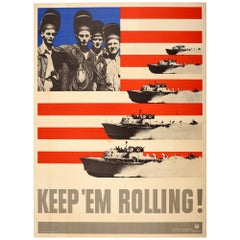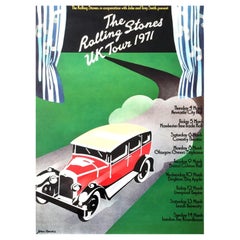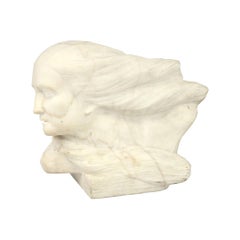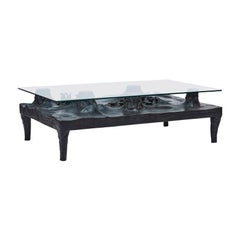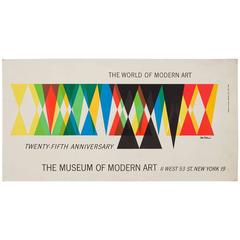Leo Lionni Furniture
to
1
1
2
1
2
1
1
1
1
1
1
2
2
2
2
2
1
7,546
3,967
2,548
2,244
Creator: Leo Lionni
Leo Lionni Original No. 1 of 6 Sculpture the "Giraluna" from Parallel Botany
By Leo Lionni
Located in Middlesex, NJ
The giraluna is a spectral plant entity from Leo Lionni's Classic alternate universe textbook Parallel Botany.
About the Sculpture:
The Giraluna
This elusive and capricious plant is the Dream Queen of parallel botany. Hydendorp, quite rightly, does not hesitate to define it as the "most parallel of plants, most plantlike of the parallels," and in so doing he stresses not so much its physiognomic oddnesses as the disconcerting normality of its shape. "If we were in the jungle," he writes, "and we found one blocking our way, we would not for an instant hesitate to hack it down with our machetes."1
But it will not be our good fortune to encounter it. If in reconstructions the Giraluna displays considerable plantness of form and an exact and convincing solidity, in its natural environment it can be perceived only as a nebulous interplay of glimmerings and empty spaces which alternate in the darkness and vaguely suggest where its outlines might be. (pl. XXIV) Its nocturnal presence, in fact, is manifested almost entirely in terms of the equivocal O'-factor of the moonbeams, which was discovered and measured a few years ago by Dennis Dobkin of the Point Paradise Observatory. This factor changes the light-shade ratio which normally defines volumes into a subtle interplay of lucencies and opacities, so that our perceptions, our basic sensorial habits conditioned by thousands of years of daytime life in the "solar key," would need complete readjustment and indeed reversal in order to come to terms with it. Daylight isolates objects, bestowing a noisy Meaning on all the odds and ends in the world. But night takes everything away except the very soul of things: a black light, a transparent darkness, a secret we cannot grasp.
During the long night of the Erocene era man caught a glimpse of the Giraluna rising mysteriously in its barren landscape. Presolar man imagined himself the child of the Moon. In her lap he had known the comfort of the life, silent torpor of the night, and by her light he had seen silver pearls lie weightlessly upon the coronas of the first great flowers. But he left us only a few enigmatic signs of all this: the Feisenburg cave, the petrified bones in the Ahmenstadt tumulus, the Boergen Cup. Paradoxically enough, all that we do in fact know of his presence in that landscape comes to us from our study of his nocturnal vegetation,
Around the middle of the Erocene era, when the flowers of night were fading away in the light of a new dawn, man saw that outlines and colors were slowly hardening. Thus he discovered the stone-hard world of day, and learned to be the child of both Sun and Moon, of Amnes and Ra, of Disarm and Karak, of Nemsa and Taor. The "crawling stones" of Yorkshire, the stele of Tapur, the graffiti of Klagenstadt, these have preserved for us the nearly obliterated images of the two divinities who from the center of their temples drew the design of the universe.
But the Sun was not long in attaining absolute power over everything in the world. "O Ra, o Amno Ra our benefactor, glowing and flaming! Gods and men bow down before you, for you are their creator and their only Lord." Such was the prayer of Amresh, High Priest of Egypt. And a new vegetation, outspoken and exuberant, appeared on the earth, and made the bright leaves dance in the morning breeze. Night soon became no more than a dark corridor joining one day to another, a place of visions and memories, a storehouse of words and images. It became a secret refuge where the vanished flowers could once more flaunt their coronas to the Moon. And thousands of years later the black flowers of that distant night-Giraluna, Lunaspora, Solea argentea-were born from seeds hidden deep in a soil rich with legends and stories.
If our knowledge of the Giraluna is today reasonably complete and detailed this is due to the industry and scholarship of Professor Johannes Hydendorp of the University of Honingen, who has collected and collated all known facts and kept his records abreast of the latest developments. Our historical and geographical information comes from the most varied sources: legends and folk tales handed down from generation to generation, accounts given by explorers, anthropologists, and paleontologists, and of course the more recent testimony of botanists such as Heinz Hornemann and Pierre Maessens.
Source: Sivatherium. narod .edu
About Sculpture:
Leo Lionni is best known today for his children's books: Little Blue and Little Yellow; Frederick—the one about the mouse who gathers poems while his family is harvesting seeds for the winter—Swimmy the Fish. Of course the children don't remember his name, but to parents and grandparents, the ones who actually do the reading, he is something of a celebrity. Most people don't realize that Lionni is also one of the 20th-century's most influential graphic designers. Within that field, he is a legend. In fact, he didn't start doing children's books until he had left the world of advertising, teaching, and design to allow more time for contemplation and for art. Little Blue and Little Yellow (1959) began as an improvised entertainment for bored grandchildren. What can you do with a few scraps of colored paper and a lot of imagination ? Make the first best-selling children's book illustrated with abstract art. Before that his work as design director for Olivetti Corporation of America and the art director of Fortune magazine, the co-founder of the Aspen...
Category
20th Century American Mid-Century Modern Leo Lionni Furniture
Materials
Bronze, Steel
Original Vintage War Poster Keep 'em Rolling WWII USA Navy Home Front PT Boats
By Leo Lionni
Located in London, GB
Original vintage World War Two poster - Keep 'Em Rolling! - featuring speeding US Navy patrol torpedo PT boats at sea across the stripes of the American flag with workers wearing wel...
Category
1940s American Vintage Leo Lionni Furniture
Materials
Paper
Related Items
1971 Rolling Stones, UK Tour Original Vintage Poster
By John Pasche
Located in Winchester, GB
Known as the "Farewell to England" tour, the Rolling Stones 1971 UK Tour took place across 10 days in March 1971 across 9 cities and saw the Stones at their absolute peak. They released the iconic "Sticky Fingers" a few weeks after the tour.
After being commissioned to create the 1970 European Tour poster, and in turn, creating the iconic Stones tongue and lip logo, British designer John Pasche was recruited to create this iconic poster. Featuring an old car driving down the countryside roads...
Category
1970s British Vintage Leo Lionni Furniture
Materials
Paper
The Wind, Original Marble Sculpture, 1920s
Located in Roma, IT
The Wind is an original marble sculpture made by Anonymous artist and realized in the 1920s.
A beautiful white marble sculpture representing a female portrait as the personificati...
Category
1920s Italian Vintage Leo Lionni Furniture
Materials
Marble
Modern Totem marble sculpture from the 1970s
Located in bari, IT
The Modern Totem " In Equilibrio Precario" sculpture made of different shapes of marble and colors created by a missed artist in the 1970s.
Category
1970s Italian Mid-Century Modern Vintage Leo Lionni Furniture
Materials
Marble
Italian crucifix Brutalist Sculpture from the 1960s
Located in bari, IT
Italian brass brutalist sculpture from the 1960s depicting a stylized crucifix.
Category
1960s Italian Brutalist Vintage Leo Lionni Furniture
Materials
Brass
Original vintage The Rolling Stones poster "Sympathy for the Devil"
Located in Brønshøj, DK
Original Danish movie poster for "Sympathy for the Devil" - in danish "sympati for Satan", 1968. The poster is made by Kirkeby Rosengreen (right bottom corner) and is marked "rented out" by Sven...
Category
1960s Danish Vintage Leo Lionni Furniture
Materials
Paper
Bronze sculpture of an Etruscan horse from the 1960s
By Frederic Weinberg
Located in Autonomous City Buenos Aires, CABA
Bronze Sculpture, Etruscan Horse from the 1960s by Frederick Weinberg
Wonderful bronze sculpture of an Etruscan horse signed Frederick Weinberg, circa 1960s, in jade green, with cres...
Category
20th Century American Mid-Century Modern Leo Lionni Furniture
Materials
Bronze
URSS Ceramic Sculpture of a Seal from the 1940s
By Imperial Russia
Located in Milano, MI
Russian USSR ceramic seal figurine, made in the 1940s
Ø 14 cm Ø 13 cm h 13 cm
Category
1940s Russian International Style Vintage Leo Lionni Furniture
Materials
Porcelain
1969 Rolling Stones in Concert Original Vintage Poster
By David Byrd
Located in Winchester, GB
Wonderful poster for The Rolling Stones' "American Tour 1969". The tour is regarded as one of the greatest of all time and was called by rock critics as "history's first mythic rock ...
Category
1960s Vintage Leo Lionni Furniture
Materials
Paper
1981 Rolling Stones - American Tour 1981 Original Vintage Poster
Located in Winchester, GB
Promoting their 1981 album "Tattoo You", the Rolling Stones American Tour of 1981 was the highest grossing tour of the year, earning over $50 million. Reaching number 1 in the charts...
Category
1980s American Vintage Leo Lionni Furniture
Materials
Paper
Wandermeerche Maternity Plaster Sculpture from the 1950s
Located in Milano, MI
Plaster sculpture depicting a motherhood, created by Wandermeesche in the 1950s
Ø cm 17 Ø cm 24 h cm 30
Category
1950s Dutch Mid-Century Modern Vintage Leo Lionni Furniture
Materials
Ceramic
"Let 'Em Have It. Buy Extra Bonds" Vintage WWII 4th War Loan Poster, 1943
Located in Colorado Springs, CO
This is an original World War II poster, dating to 1943. The poster reads "Let 'Em Have It" and “Buy Extra Bonds” in bold yellow and white block letters. The poster's composition features a soldier throwing a grenade on the battlefield. Black and blue smoked filled skies and barbed wire are seen behind him. The 4th War Loan Shield is illustrated prominently at center left. The poster was illustrated by Bernard Perlin...
Category
1940s American Vintage Leo Lionni Furniture
Materials
Paper
H 29.75 in W 21.5 in D 1.75 in
Leo Osborne "The Prince" Figural Seated Lion Bronze Sculpture Statue Burled 25"
Located in Dayton, OH
"The Prince" by Leo Osborne, Limited Edition of 15
Features a recumbent lion. First made in a wooden burl, then molded for bronze. A beautiful addition to...
Category
Late 20th Century Leo Lionni Furniture
Materials
Burl
H 10.5 in W 21 in D 25 in
Previously Available Items
Contemporary Bronze Coffee Table by Leo Lionni, a Unique Piece
By Leo Lionni
Located in London, GB
Bronze coffee table by Leo Lionni, with crystal glass top. Signed. A unique piece. The table depicts a pastoral scene with trees and flowers, some of which have a gilt bronze patination. A longer glass table...
Category
1990s Italian Post-Modern Leo Lionni Furniture
Materials
Bronze
25th Anniversary MoMA Poster by Leo Lionni
By Leo Lionni
Located in Brooklyn, NY
Archiving the younger years of New York’s very own Museum of Modern Art, this vibrant, vintage 25th Anniversary MoMA poster was designed by children’s illu...
Category
1950s American Mid-Century Modern Vintage Leo Lionni Furniture
Bronze Coffee Table by Leo Lionni
By Leo Lionni
Located in London, GB
Bronze coffee table by Leo Lionni, with crystal glass top. Signed. A unique piece.
Category
1990s Italian Post-Modern Leo Lionni Furniture
Leo Lionni furniture for sale on 1stDibs.
Leo Lionni furniture are available for sale on 1stDibs. These distinctive items are frequently made of steel and are designed with extraordinary care. There are many options to choose from in our collection of Leo Lionni furniture, although gold editions of this piece are particularly popular. Many of the original furniture by Leo Lionni were created in the mid-century modern style in united states during the 20th century. If you’re looking for additional options, many customers also consider furniture by David Segel, Naomi Feinberg, and Larry Mohr.

